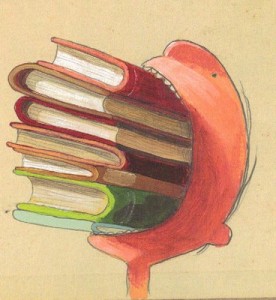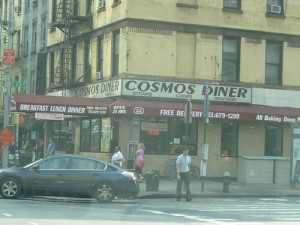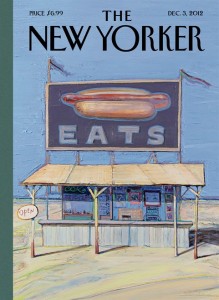HG likes to eat (and drink). And, when not indulging in these ever bright pleasures, HG likes to read about them. The most appetizing book about these subjects is Between Meals: An Appetite For Paris by A.J. Liebling, the New Yorker writer who had a prodigious appetite and a prodigious talent. He said of himself: “I write faster than anyone who writes better, and better than anyone who writes faster.” The book deals with Liebling’s culinary (and amorous life) in Paris. It’s witty, erudite and wonderfully evocative of that magical city. M.F.K Fisher is another writer who has written well of France, food, love and loss. Her prose is impeccable. Her recipes are terrible. Waverley Root has written definitive books about the food and wine of France and Italy. Nice analysis of tastes and regional specialties. Alexander Lobrano, Patricia Wells and blogger John Talbott are reliable reviewers of today’s Paris restaurants. Best of all New York restaurant reviewers was the late Seymour Britchky. Irreverent, funny and accurate. He died in 2004 and HG misses his acid reviews of pretentious restaurants. The New York Times, of course, has been the leader in restaurant reviewing. Craig Claiborne was the pioneer. Good judgment but much impressed by mediocre Chinese restaurants and Jewish delicatessens (probably due to a provincial Mississippi youth). Mimi Sheraton was HG’s favorite Times critic. Sheraton combined a love of “haimish” cooking with a taste for big, international flavors. HG also much enjoyed Ruth Reichl’s work at the Times before she moved on to Gourmet Magazine (sadly,no longer published). Current critic Pete Wells is at his best when he’s being destructive. Otherwise, he seems a bit too arch and precious. Sam Sifton, the food editor, is splendid. He’s made the Times a rich source of recipes and ideas for delicious home cooking (Melissa Clark is a standout. HG finds Mark Bittman uneven). Joseph Wechsberg, who wrote about European restaurants (and much else) for the New Yorker is ripe for rediscovery. And, HG recalls with fondness the down to earth midwestern flavored food writing of Clementine Paddleford (great name) of the long demised New York Herald Tribune. Calvin Trillin is the poet laureate of barbecue and other indigenous American foods (however, HG can never understand his love for the vastly overrated Mosca’s Restaurant near New Orleans). Jane and Michael Stern’s books about highway and roadside restaurants were lively and wildly influential but their selections are very uneven. They liked some terrible Tex-Mex and hamburger joints in Colorado but led HG/BSK to some very good eating in Montana and Washington. So, take their recommendations with caution.
Appetizing Writers
September 28th, 2015 § 2 comments § permalink
Old Fogey Food Memories
September 22nd, 2015 § 0 comments § permalink
Mimi Sheraton, who is one of HG’s favorite food/restaurant writers (she was the NY Times restaurant critic for many years), once recalled the chow mein she ate in Brooklyn restaurants during her youth: “I still remember the mild soothing taste of that food, primarily the flavors of celery, bean sprouts and onions. It is far removed from the sophisticated (and truly better) Chinese food now fashionable, but there are moments when I would trade six of the best Szechuan meals in town for one plateful of that old chow mein (pronounced ‘sharmane’) nostalgia.”) The quote is from Sheraton’s book, From My Mother’s Kitchen. an indispensable guide to Jewish family cooking. Yes, HG shares her chow mein nostalgia. HG often enjoyed the terribly messy but strangely appealing chow mein sandwiches dispensed by the Nathan’s Famous hot dog emporiums in Coney Island and Manhattan’s Seventh Avenue. Years ago, HG and gourmand companion Charles E., would meet for a stealthy lunch in a dimly lit Sixth Avenue Chinese restaurant. They would devour “combo platters” of chow mein, fried rice and greasy egg rolls. Like illicit lovers, they would leave the restaurant swiftly and furtively to avoid being seen by friends with elevated dining tastes. Yes, nostalgia has a kick: A week or so ago, a ferocious north wind was battering Prince Edward Island. Outside, the windows of HG/BSK’s home revealed a sea topped with a froth of whitecaps. For some obscure reason, the tumultuous weather made HG remember the plain-spoken comfort food HG enjoyed decades ago in New York bar-and-grills, diners and coffee shops: Corned beef and cabbage with boiled potatoes on Third Avenue (when the El rumbled overhead). Open faced pot roast sandwiches drenched in rich brown gravy. Ditto open faced turkey and roast beef sandwiches (accompanied by mashed potatoes and cranberry sauce or insipid vegetables). liver and onions topped with bacon. Salami and eggs served “pancake style.” Spaghetti (never al dente, always overdone) with big meatballs and “red sauce.” A simple “bowl of red”–chili topped with raw onions and grated cheddar. BLT’s on whole wheat toast with loads of mayo. That night BSK and HG devised a PEI dinner that provided comfort: Grilled weissurst (veal) sausages with sweet mustard. Sauerkraut. Boiled local potatoes. Yellow bean salad. Gahan’s PEI ale. There was a fire in the Danish stove and sounds of Mozart. The winds did blow. The sea surged. And HG/BSK (and Toby, The Wonder Dog), were snug in their comfort zone.
Cookbooks
July 20th, 2013 § 0 comments § permalink
Cookbooks make for pleasant reading and often better viewing (some cookbook photography is so lustfully shot that it is basically pornographic). They often have good cooking ideas and can serve as an active spur to the imagination. But, very few contain recipes that, when followed step-by-step, turn out right. Mark Bittman, the ubiquitous Bittman, is the great advocate of simplicity and a best-selling cookbook author. In HG’s opinion, Bittman’s recipes disappoint. They should be read as creative outlines to constructing a dish rather than precise instructions. The recipes in Saveur Magazine sure read good but make for unfortunate eating (SJ disagrees). HG relies on three cookbook authors: Mimi Sheraton (the former New York Times restaurant reviewer); the late Michael Field and Marcella Hazan, the woman who has had a powerful and positive impact on cooking Italian food in the home kitchen. Mimi Sheraton’s cookbook, From My Mother’s Kitchen, is an HG favorite. There is a strong emphasis on Jewish cooking (but not kosher—there are good recipes for clams, lobster and a ham-and-bean soup). The recipes are can’t miss and they emphasize simple things like matzo brei, blintzes, fish salads, pan broiled steaks and hamburgers, etc. Michael Field’s books feature precise recipes. Do exactly as he says and you have a winner dish. Always. Marcella Hazan is invaluable. However, it is necessary to adjust the quantities. She likes, in the Italian fashion, a lot of pasta and a little bit of sauce. A lot of Americans (including HG/BSK) like the reverse.
New Yorker Food Issue
December 6th, 2012 § 0 comments § permalink
The annual New Yorker Food Issue is out and has some good reading for the food obsessed. Calvin Trillin has a piece on the cuisine of Oaxaca, Mexico. Makes you want to grab the next plane to that city even if you have no desire to eat caterpillars and worms, two local specialties. Mimi Sheraton does a riff on sausages including a description of a goose and goose liver sausage she ate in Hamburg some years ago. Very appetite provoking. HG has always felt Mimi Sheraton was the best of the New York Times restaurant reviewers. She reigned between 1975-1983. She was fair, balanced and funny. She concentrated on a restaurant’s food rather than going on and on about the hipness (or lack) of the restaurant’s clientele. Sheraton has written some good books. From My Mother’s Kitchen is a delightful memoir and very evocative of a vanished New York. As a plus, it has some good, down to earth recipes. HG liked Craig Claiborne, the original Times reviewer. However, like many a New York transplant from the South, Claiborne never met a Jewish delicatessen or Chinese restaurant he didn’t love. The man had great judgement in matters concerning French cuisine. But, when it came to pastrami or shrimp in black bean sauce — Fuhgeddabout it!!
When Muffins Met Modernism & A Jewish Bakery Detour
June 13th, 2012 § 0 comments § permalink
In 1930s New York, many apartment buildings, shops (and restaurants) were designed in a streamlined, modernist style — a kind of Art Deco for the masses. While true Art Deco (which reached its height in Paris of the 20s and 30s) was very elegant and seriously luxurious, the young American designers who piggy backed on the Art Deco style were a bit more egalitarian. Their best efforts, in terms of major structures, can be seen in the apartment houses that line the Grand Concourse in the Bronx and the glorious hotels of Miami’s South Beach. Smaller design gems were the chain bakeries that flourished in all of New York’s neighborhoods. The aim of all the “streamlining” was to give shoppers an optimistic lift in the gloom of the Great Depression. The “streamlined” bakeries were Cushman’s and Hanscom’s. The famed industrial designer Raymond M. Loewy designed Cushman’s and Horace Ginsbern designed Hanscom’s. (Ginsbern, then fairly young, later became one of New York’s most prominent apartment house architects. Ginsbern was born in 1893 and died in 1969. Scores of his buildings exist in Manhattan’s Upper East Side).
The architect Robert A.M. Stern has commented on the Loewy and Ginsbern bakery designs: “They brought a relatively high level of International Style Modernism into virtually every New York neighborhood.”
Cushman’s had white porcelain facades; nautical, oval windows and the name was spelled out in a curving, gold script. Hanscom’s had apple green porcelain facades and the name was formed with blocky, super- modern letters. Stern described the entire architectual composition as “Constructivist.”
In the Bronx you had Jewish Bakeries and Italian bakeries. The Jewish bakeries had elaborate butter cream cakes and, of course, bagels, bialys, rye and pumpernickel bread, etc. These were jammed on Sunday mornings with Dads buying bread-stuffs for brunch (The casual tweed and camel hair jackets many of them wore were known as “bagel coats”). The Italian bakeries, in neighborhoods like Belmont, had, of course, sublime bread, delicious cannolis, pignoli cookies and other Italian specialties. There was plenty of cross pollination. Jews liked the corn muffins and cookies at Cushman’s and Hanscom’s (which were generalized as goyish bakeries) and there were plenty of bagel and rye bread fanciers among the non-Jewish population. And, of course, everyone loved their Italian baked goods. Some Jewish bakery survivors in Manhattan are Moishe’s Bakery on 2nd Ave, Streit’s, which bakes and sells matzos, macaroons, kichel and other stuff from a 47,000 foot factory on Rivington Street and Kossar’s which bakes and sells bialys and other traditional good stuff from a location near the Essex Street Market. SJ sent HG a batch of Kossar’s products a few months ago producing moans of delight. The eminent food writer, Mimi Sheraton, a woman who knows Jewish food, says a Kossar’s bialy is the only true bialy baked in the United States. HG agrees.
Interestingly, HG’s Mom never called a bialy by that shortened name. She paid appropriate homage by calling it a Bialyosteker Kuchen.
Finicky Foodies
September 21st, 2011 § 2 comments § permalink
So, Sam Sifton, the all-powerful New York Times restaurant critic, is no longer the make-or-break-restaurant Times fresser. He has been promoted to National Editor. All in all, HG liked Sifton’s reign even though his star ratings seemed erratic. Hope he continues to contribute recipes for the Sunday Times Magazine. They are simple, earthy and good.
At one time, Clementine Paddleford (love that name) of the defunct Herald-Tribune was the chief New York food scribe. But, it was Craig Claiborne of the New York Times who elevated the status and power of the American restaurant critic. (Does anyone remember the $4000 meal CC shared with his collaborator, Pierre Franey, at Chez Denis–long closed–in Paris?). CC had taste and knowledge but was a sucker for Chinese restaurants and Jewish delicatessens. Relentlessly overpraised them.
HG quite liked Claiborne’s female successors, Mimi Sheraton and Ruth Reichl. Another woman who could write about food was the lusty and lustful Gael Green of New York Magazine. HG misses her presence at the mag (HG gathers she’s now contributing to Crain’s New York Business).
The dining reviews in The New Yorker seem fey and uneven. HG is not fond of Zagat and finds all guidebooks misinformed or out of date.
In the end HG agrees with SJ: Best restaurant critic, bar none, is the great and adventurous David Sietsma of the Village Voice. He is a man whose palate knows no fear and is willing to travel to the ends of New York City to track down the best food from Burkina Faso or a particularly talked about slice of Pizza. He is the opposite of pretentious and a downright hilarious writer to boot. A true New York treasure and just about the only reason to pick up the Village Voice.




